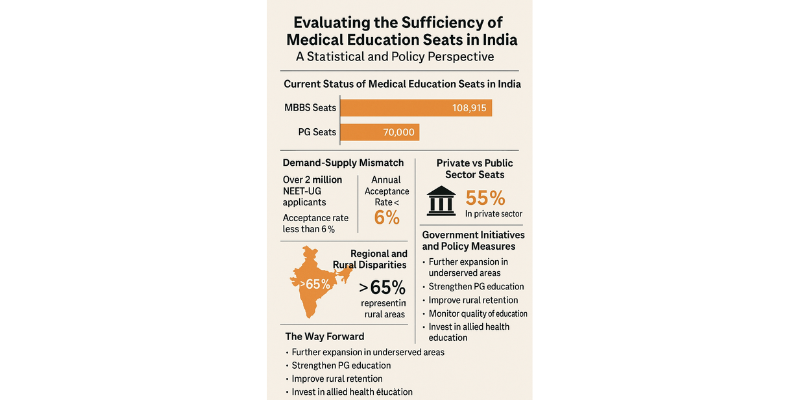Introduction
With a population exceeding 1.4 billion, India faces an enormous healthcare burden. Addressing the nation’s diverse and complex health challenges requires an adequate number of well-trained medical professionals. Among the fundamental steps is ensuring the availability of sufficient medical education seats—especially at the undergraduate (MBBS) and postgraduate (PG) levels. Despite steady improvements in infrastructure and policy, a critical question persists: Are medical seats in India sufficient to meet the healthcare and educational demands of the country? This essay evaluates the current status of medical seats, the increasing need for healthcare professionals, regional disparities, and potential policy solutions.
Current Status of Medical Education Seats in India
As of 2024, India has over 706 MBBS colleges with a combined annual intake of approximately 108,915 MBBS seats, as per the National Medical Commission (NMC). This marks a near doubling from around 54,000 seats in 2014, reflecting a strong governmental push to enhance healthcare access by strengthening human resources.
On the postgraduate front, there are about 70,000 PG seats, including Doctor of Medicine (MD), Master of Surgery (MS), and Diplomate of National Board (DNB) programs. However, the imbalance between MBBS and PG seats creates a bottleneck, making postgraduate medical admission highly competitive.
Demand-Supply Mismatch
The World Health Organization (WHO) recommends a doctor-patient ratio of 1:1000. According to a 2023 NITI Aayog report, India approaches this ratio at 1:834, but this figure includes all registered allopathic doctors, regardless of active practice. When only actively practicing MBBS doctors are considered, the ratio drops to 1:1500 or worse in many states.
Each year, over 2 million students compete in the NEET-UG for roughly 100,000 MBBS seats, yielding a selection rate of less than 6%. This intense competition highlights the severe gap between demand and available seats. At the PG level, only about 50% of MBBS graduates secure a seat, pushing many to attempt exams multiple times or seek costly education abroad.
Regional and Rural Disparities
Beyond the total number of seats, their geographical distribution is a major concern. Southern states like Tamil Nadu, Karnataka, and Andhra Pradesh host a disproportionate number of colleges, while states such as Bihar, Jharkhand, and those in the Northeast remain underserved. Aspiring medical students from these areas often face relocation or are unable to pursue medicine altogether.
Rural India, home to over 65% of the population, suffers acutely from physician shortages. The Rural Health Statistics 2023 report reveals that over 80% of Community Health Centres (CHCs) lack specialist doctors. This urban-rural divide is aggravated by the concentration of medical colleges in cities, where graduates prefer to remain for better infrastructure and career opportunities.
Private vs. Public Sector Seats
Around 55% of MBBS seats are in private medical colleges. While this expansion helps boost numbers, it also raises concerns regarding affordability and quality. Private colleges often charge ₹50 lakh to ₹1.5 crore, compared to ₹1–5 lakh in government institutions. This disparity makes medical education inaccessible to many deserving candidates from economically weaker backgrounds.
Government Schemes and Policy Initiatives
The government has introduced multiple initiatives to address these gaps. The Centrally Sponsored Scheme for the Development of New Medical Colleges has approved 157 new colleges since 2014, mainly in underserved regions. Additionally, reforms such as the National Exit Test (NEXT) aim to standardize final-year MBBS assessments, serve as a licensure examination, and streamline PG admissions.
The All India Quota (AIQ) mechanism has also improved equitable seat distribution across states, ensuring better access for students nationwide.
The Way Forward
To address existing shortcomings, a multi-pronged approach is essential:
-
Expand Access in Underserved States
Encourage both public and affordable private colleges in states with low seat density. -
Increase PG Seats Proportionately
Narrow the gap between UG and PG seats to reduce competitive pressure and brain drain. -
Incentivize Rural Practice
Introduce financial incentives, career growth opportunities, and PG admission advantages for rural postings. -
Ensure Quality Across Institutions
Strengthen accreditation and regular audits, especially for private colleges, to maintain education standards. -
Invest in Allied Health Education
Expand training for nurses, lab technicians, and paramedics to support physicians and provide comprehensive healthcare.
Conclusion
India has made significant progress in expanding medical education seats over the last decade. However, mere numbers do not equate to sufficiency. Persistent challenges—including demand-supply mismatches, regional inequalities, and affordability issues—continue to affect access and quality. While the absolute number of MBBS seats may appear adequate, true progress lies in equitable distribution, postgraduate accessibility, and rural retention of medical professionals. A holistic, inclusive, and forward-thinking strategy is essential to strengthen India’s healthcare system for future generations.




